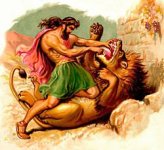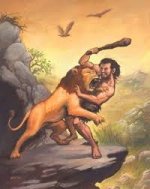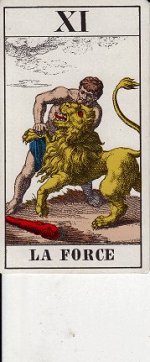Inconnu
I'm going through my Visconti pack lately, reflecting on the images & something struck me about the strength card. Traditional imagery has a female in control of a roaring lion, seeming to sooth the savage beast. While not necessarily in conflict they are seemingly not in agreement.
The Visconti shows a young man with a club & a lion both looking as if they are on the attack. But not attacking each other, they're both facing the same direction (right) & their eyes are looking at the same point, outside the card. They seem to be in agreement.
I've compared all the Major & Court cards to the Strength card but don't find an obvious adversary. I wonder what the meaning of this depiction means.
I can't put up images here but I hope this link will work
What's the protagonist to the Visconti Strength card? https://tarotmeditations.wordpress.com/decks/visconti-sforza/#jp-carousel-1415
The Visconti shows a young man with a club & a lion both looking as if they are on the attack. But not attacking each other, they're both facing the same direction (right) & their eyes are looking at the same point, outside the card. They seem to be in agreement.
I've compared all the Major & Court cards to the Strength card but don't find an obvious adversary. I wonder what the meaning of this depiction means.
I can't put up images here but I hope this link will work
What's the protagonist to the Visconti Strength card? https://tarotmeditations.wordpress.com/decks/visconti-sforza/#jp-carousel-1415





